Abstract
CGP 53437 is a peptidomimetic inhibitor of human immunodeficiency virus type 1 (HIV-1) protease containing a hydroxyethylene isostere. The compound inhibited recombinant HIV-1 protease with a Ki of 0.2 nM. The inhibition constant versus human cathepsin D and human cathepsin E was 4 nM. Human pepsin and gastricsin were inhibited with Kis of 8 and 500 nM, respectively, and human renin was inhibited with a Ki of 190 microM. The replication of HIV-1/LAV, HIV-1/Z-84, and HIV-1/pLAI was inhibited with a 90% effective dose of 0.1 microM in acutely infected MT-2 cells. The 50% cytotoxic dose was 100 microM. Similar antiviral activity was observed when the compound was added up to 10 h after infection. At the effective concentration, processing of Gag precursor protein p55 was greatly reduced, confirming an action on the late stage of the virus life cycle, as expected. The efficacy of the inhibitor was also demonstrated by using primary human peripheral blood lymphocytes infected with the HIV-1/LAV strain, low-passage clinical isolates obtained from HIV-1-seropositive individuals (including a zidovudine-resistant strain), and HIV-2/ROD. In these cells, CGP 53437 delayed the onset of HIV replication in a dose-dependent fashion (substantial effects with concentrations of > or = 0.1 microM) as long as the inhibitor was maintained in the culture. CGP 53437 was orally bioavailable in mice. Concentrations in plasma 10-fold in excess of the in vitro antiviral 90% effective dose could be sustained for several hours after oral application of 120 mg/kg. Therefore, CGP 53437 has the potential to be a therapeutically useful anti-HIV agent for the treatment of AIDS.
Full text
PDF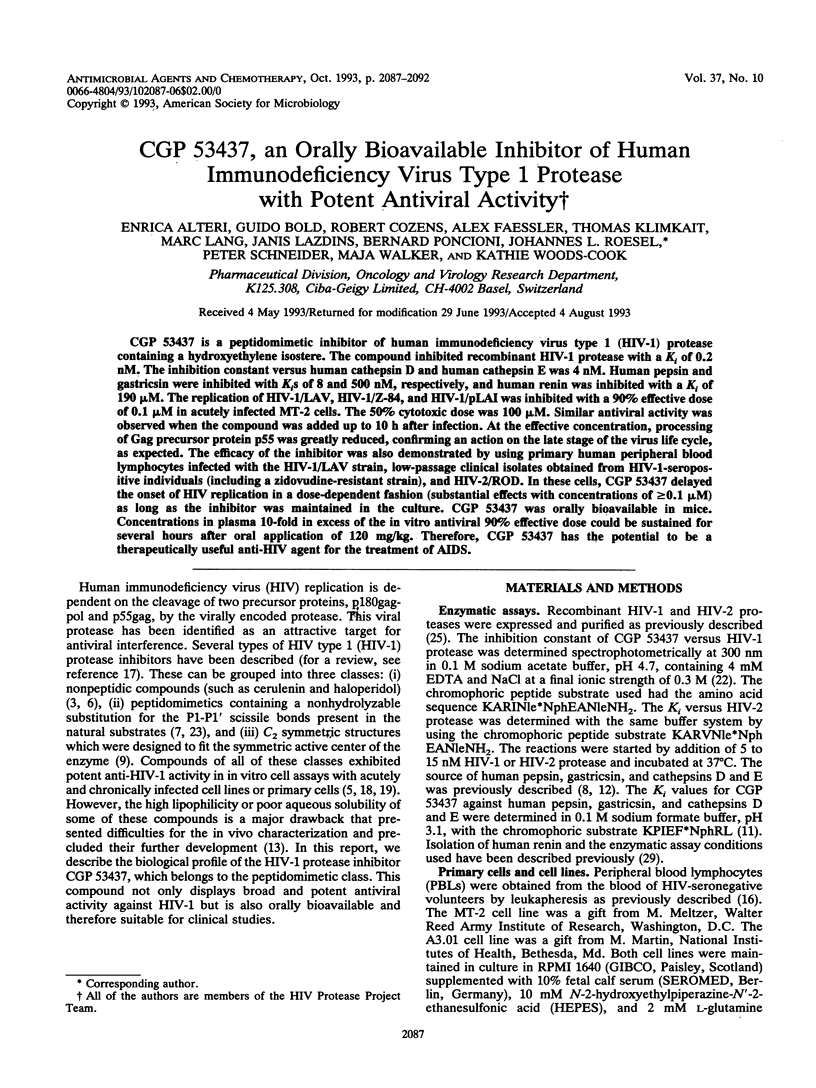
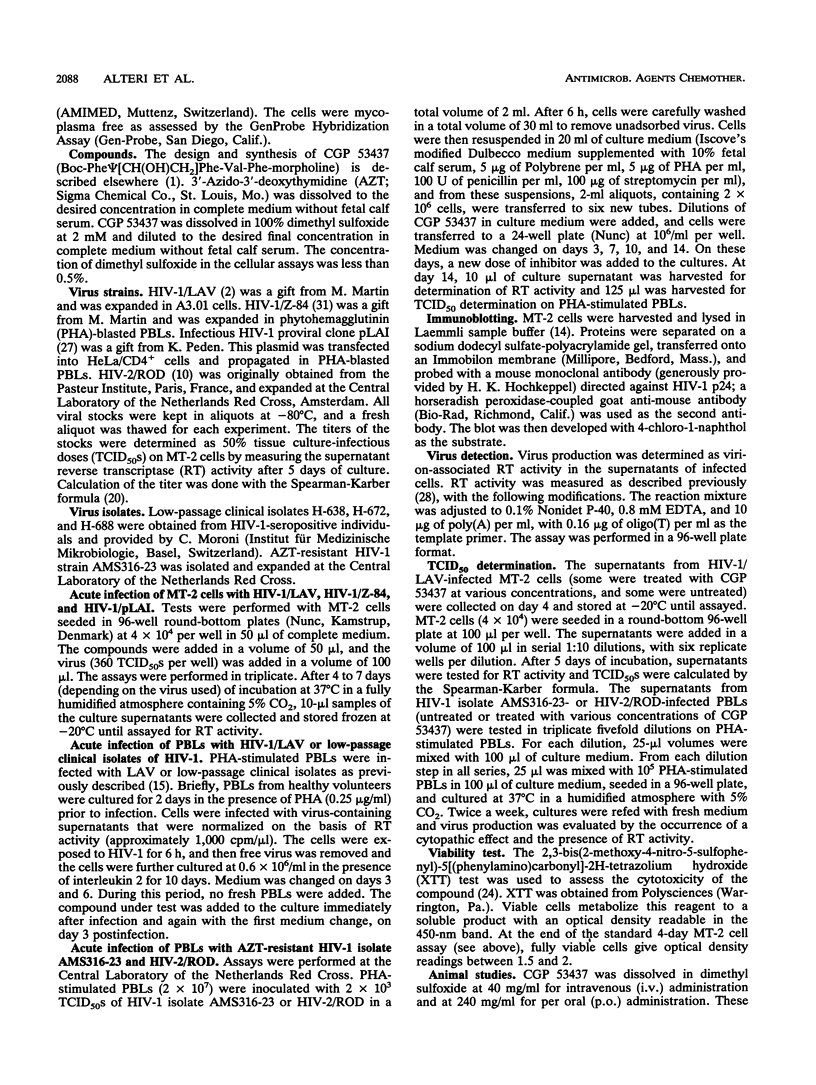
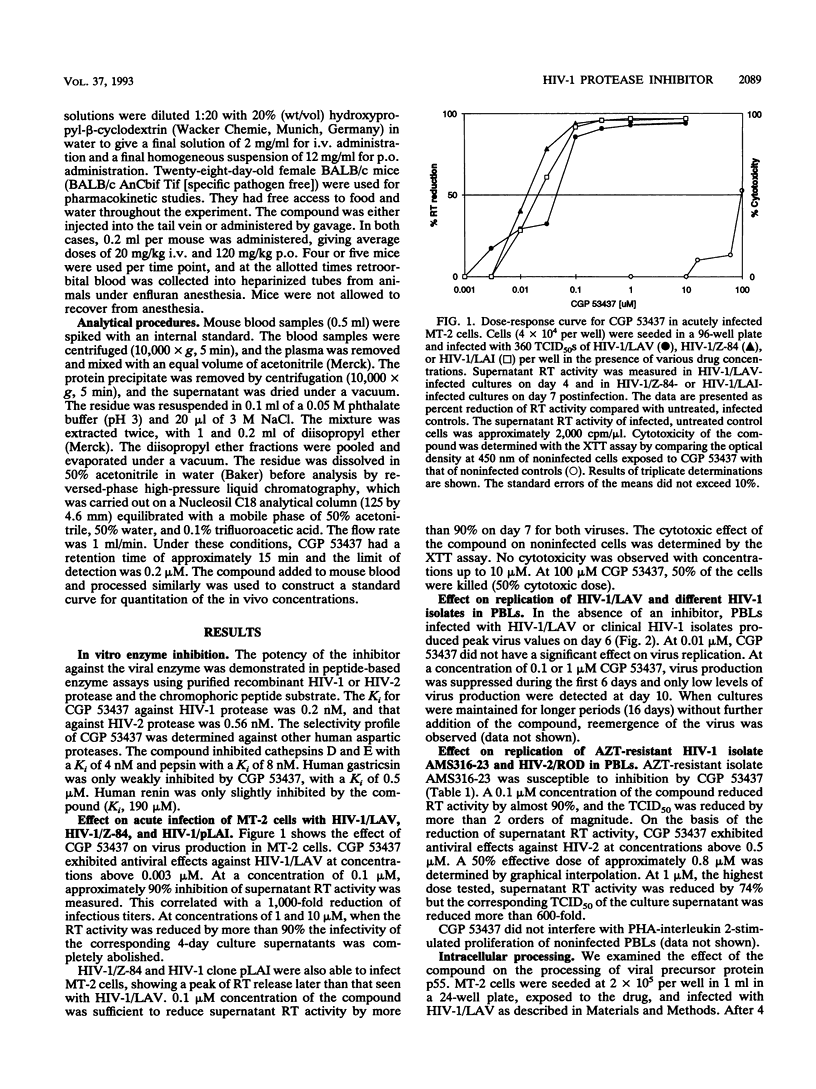
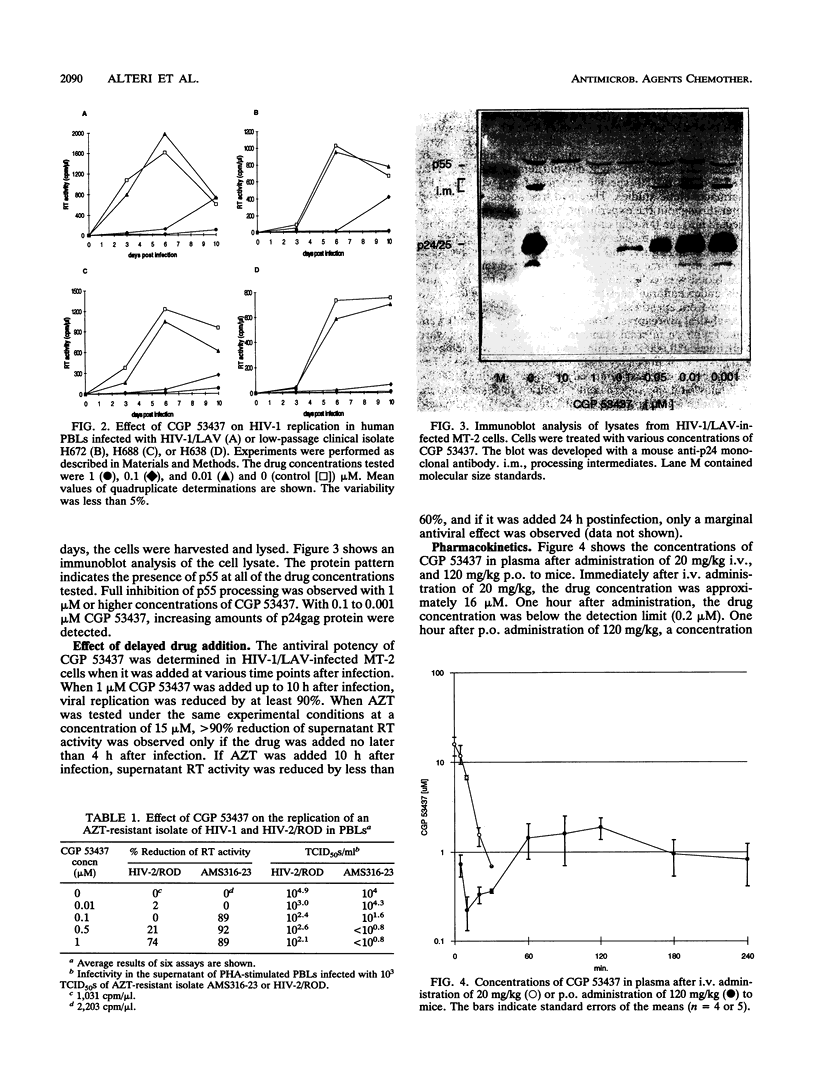
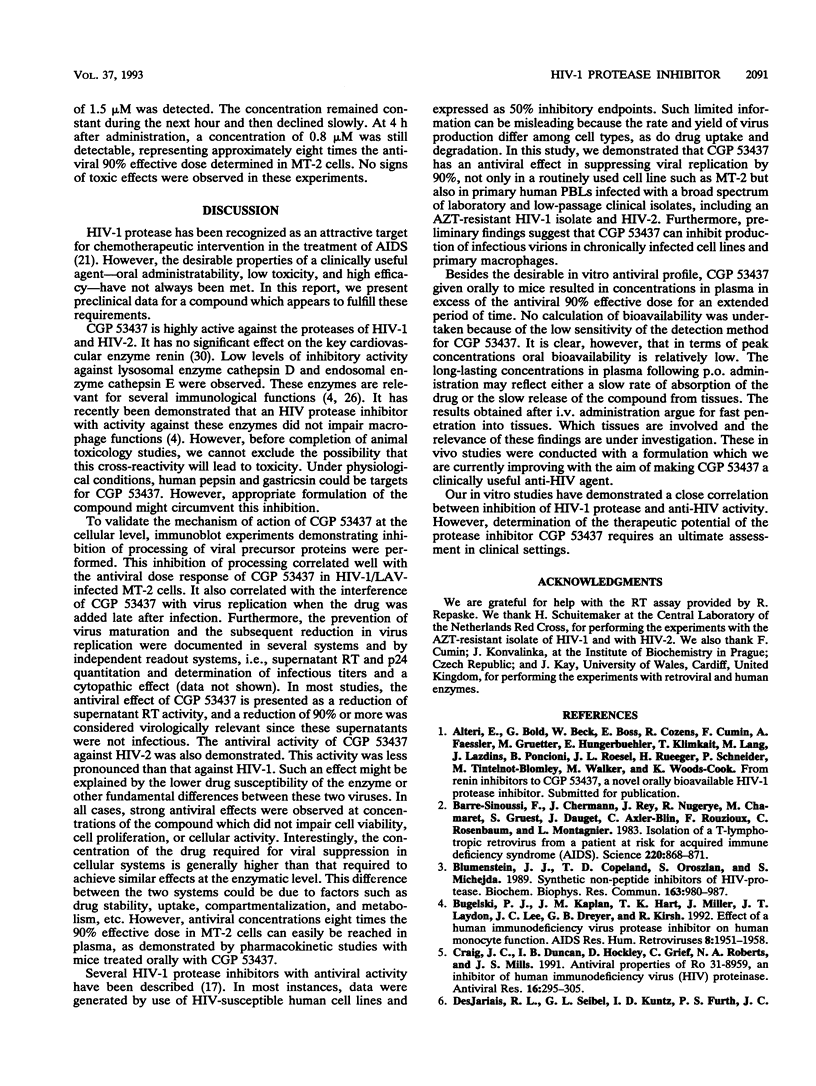
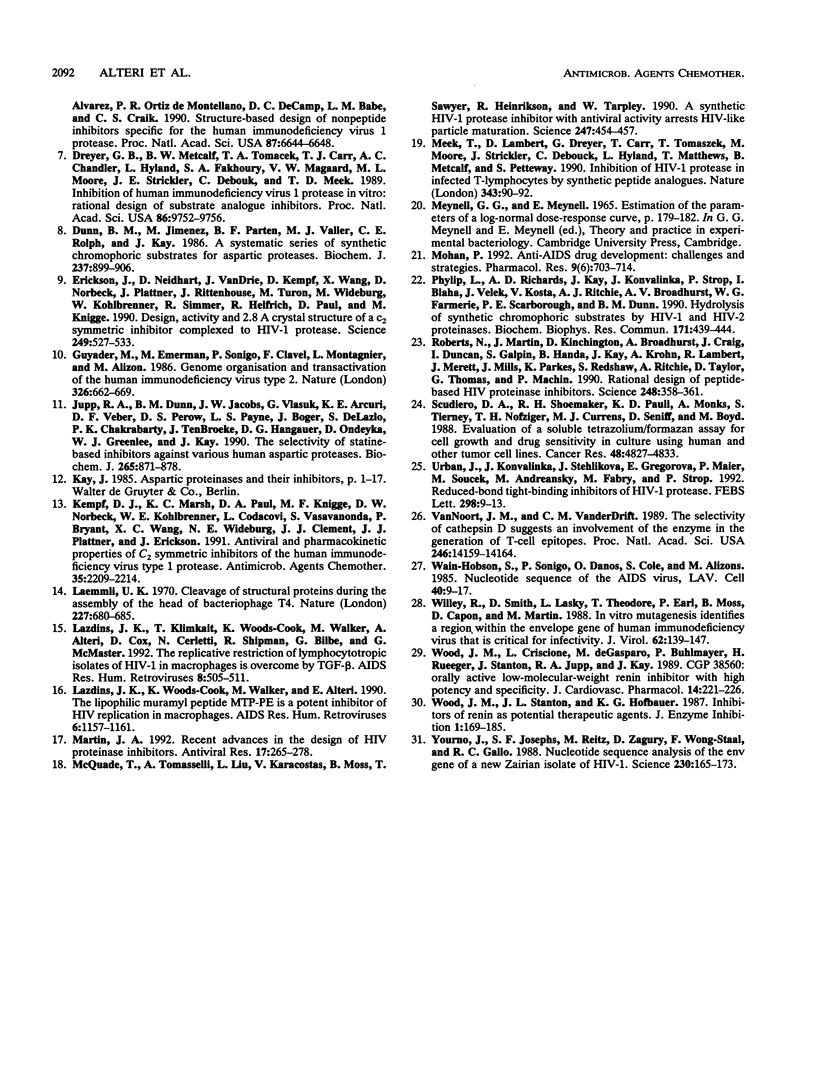
Images in this article
Selected References
These references are in PubMed. This may not be the complete list of references from this article.
- Barré-Sinoussi F., Chermann J. C., Rey F., Nugeyre M. T., Chamaret S., Gruest J., Dauguet C., Axler-Blin C., Vézinet-Brun F., Rouzioux C. Isolation of a T-lymphotropic retrovirus from a patient at risk for acquired immune deficiency syndrome (AIDS). Science. 1983 May 20;220(4599):868–871. doi: 10.1126/science.6189183. [DOI] [PubMed] [Google Scholar]
- Blumenstein J. J., Copeland T. D., Oroszlan S., Michejda C. J. Synthetic non-peptide inhibitors of HIV protease. Biochem Biophys Res Commun. 1989 Sep 15;163(2):980–987. doi: 10.1016/0006-291x(89)92318-8. [DOI] [PubMed] [Google Scholar]
- Bugelski P. J., Kaplan J. M., Hart T. K., Miller J., Laydon J. T., Lee J. C., Dreyer G. B., Kirsh R. Effect of a human immunodeficiency virus protease inhibitor on human monocyte function. AIDS Res Hum Retroviruses. 1992 Dec;8(12):1951–1958. doi: 10.1089/aid.1992.8.1951. [DOI] [PubMed] [Google Scholar]
- Craig J. C., Duncan I. B., Hockley D., Grief C., Roberts N. A., Mills J. S. Antiviral properties of Ro 31-8959, an inhibitor of human immunodeficiency virus (HIV) proteinase. Antiviral Res. 1991 Dec;16(4):295–305. doi: 10.1016/0166-3542(91)90045-s. [DOI] [PubMed] [Google Scholar]
- DesJarlais R. L., Seibel G. L., Kuntz I. D., Furth P. S., Alvarez J. C., Ortiz de Montellano P. R., DeCamp D. L., Babé L. M., Craik C. S. Structure-based design of nonpeptide inhibitors specific for the human immunodeficiency virus 1 protease. Proc Natl Acad Sci U S A. 1990 Sep;87(17):6644–6648. doi: 10.1073/pnas.87.17.6644. [DOI] [PMC free article] [PubMed] [Google Scholar]
- Dreyer G. B., Metcalf B. W., Tomaszek T. A., Jr, Carr T. J., Chandler A. C., 3rd, Hyland L., Fakhoury S. A., Magaard V. W., Moore M. L., Strickler J. E. Inhibition of human immunodeficiency virus 1 protease in vitro: rational design of substrate analogue inhibitors. Proc Natl Acad Sci U S A. 1989 Dec;86(24):9752–9756. doi: 10.1073/pnas.86.24.9752. [DOI] [PMC free article] [PubMed] [Google Scholar]
- Dunn B. M., Jimenez M., Parten B. F., Valler M. J., Rolph C. E., Kay J. A systematic series of synthetic chromophoric substrates for aspartic proteinases. Biochem J. 1986 Aug 1;237(3):899–906. doi: 10.1042/bj2370899. [DOI] [PMC free article] [PubMed] [Google Scholar]
- Erickson J., Neidhart D. J., VanDrie J., Kempf D. J., Wang X. C., Norbeck D. W., Plattner J. J., Rittenhouse J. W., Turon M., Wideburg N. Design, activity, and 2.8 A crystal structure of a C2 symmetric inhibitor complexed to HIV-1 protease. Science. 1990 Aug 3;249(4968):527–533. doi: 10.1126/science.2200122. [DOI] [PubMed] [Google Scholar]
- Guyader M., Emerman M., Sonigo P., Clavel F., Montagnier L., Alizon M. Genome organization and transactivation of the human immunodeficiency virus type 2. Nature. 1987 Apr 16;326(6114):662–669. doi: 10.1038/326662a0. [DOI] [PubMed] [Google Scholar]
- Jupp R. A., Dunn B. M., Jacobs J. W., Vlasuk G., Arcuri K. E., Veber D. F., Perlow D. S., Payne L. S., Boger J., de Laszlo S. The selectivity of statine-based inhibitors against various human aspartic proteinases. Biochem J. 1990 Feb 1;265(3):871–878. doi: 10.1042/bj2650871. [DOI] [PMC free article] [PubMed] [Google Scholar]
- Kempf D. J., Marsh K. C., Paul D. A., Knigge M. F., Norbeck D. W., Kohlbrenner W. E., Codacovi L., Vasavanonda S., Bryant P., Wang X. C. Antiviral and pharmacokinetic properties of C2 symmetric inhibitors of the human immunodeficiency virus type 1 protease. Antimicrob Agents Chemother. 1991 Nov;35(11):2209–2214. doi: 10.1128/aac.35.11.2209. [DOI] [PMC free article] [PubMed] [Google Scholar]
- Laemmli U. K. Cleavage of structural proteins during the assembly of the head of bacteriophage T4. Nature. 1970 Aug 15;227(5259):680–685. doi: 10.1038/227680a0. [DOI] [PubMed] [Google Scholar]
- Lazdins J. K., Klimkait T., Woods-Cook K., Walker M., Alteri E., Cox D., Cerletti N., Shipman R., Bilbe G., McMaster G. The replicative restriction of lymphocytotropic isolates of HIV-1 in macrophages is overcome by TGF-beta. AIDS Res Hum Retroviruses. 1992 Apr;8(4):505–511. doi: 10.1089/aid.1992.8.505. [DOI] [PubMed] [Google Scholar]
- Lazdins J. K., Woods-Cook K., Walker M., Alteri E. The lipophilic muramyl peptide MTP-PE is a potent inhibitor of HIV replication in macrophages. AIDS Res Hum Retroviruses. 1990 Oct;6(10):1157–1161. doi: 10.1089/aid.1990.6.1157. [DOI] [PubMed] [Google Scholar]
- Martin J. A. Recent advances in the design of HIV proteinase inhibitors. Antiviral Res. 1992 Apr;17(4):265–278. doi: 10.1016/0166-3542(92)90022-w. [DOI] [PubMed] [Google Scholar]
- McQuade T. J., Tomasselli A. G., Liu L., Karacostas V., Moss B., Sawyer T. K., Heinrikson R. L., Tarpley W. G. A synthetic HIV-1 protease inhibitor with antiviral activity arrests HIV-like particle maturation. Science. 1990 Jan 26;247(4941):454–456. doi: 10.1126/science.2405486. [DOI] [PubMed] [Google Scholar]
- Meek T. D., Lambert D. M., Dreyer G. B., Carr T. J., Tomaszek T. A., Jr, Moore M. L., Strickler J. E., Debouck C., Hyland L. J., Matthews T. J. Inhibition of HIV-1 protease in infected T-lymphocytes by synthetic peptide analogues. Nature. 1990 Jan 4;343(6253):90–92. doi: 10.1038/343090a0. [DOI] [PubMed] [Google Scholar]
- Mohan P. Anti-AIDS drug development: challenges and strategies. Pharm Res. 1992 Jun;9(6):703–714. doi: 10.1023/a:1015882901078. [DOI] [PubMed] [Google Scholar]
- Phylip L. H., Richards A. D., Kay J., Kovalinka J., Strop P., Blaha I., Velek J., Kostka V., Ritchie A. J., Broadhurst A. V. Hydrolysis of synthetic chromogenic substrates by HIV-1 and HIV-2 proteinases. Biochem Biophys Res Commun. 1990 Aug 31;171(1):439–444. doi: 10.1016/0006-291x(90)91412-l. [DOI] [PubMed] [Google Scholar]
- Roberts N. A., Martin J. A., Kinchington D., Broadhurst A. V., Craig J. C., Duncan I. B., Galpin S. A., Handa B. K., Kay J., Kröhn A. Rational design of peptide-based HIV proteinase inhibitors. Science. 1990 Apr 20;248(4953):358–361. doi: 10.1126/science.2183354. [DOI] [PubMed] [Google Scholar]
- Scudiero D. A., Shoemaker R. H., Paull K. D., Monks A., Tierney S., Nofziger T. H., Currens M. J., Seniff D., Boyd M. R. Evaluation of a soluble tetrazolium/formazan assay for cell growth and drug sensitivity in culture using human and other tumor cell lines. Cancer Res. 1988 Sep 1;48(17):4827–4833. [PubMed] [Google Scholar]
- Urban J., Konvalinka J., Stehlíková J., Gregorová E., Majer P., Soucek M., Andreánsky M., Fábry M., Strop P. Reduced-bond tight-binding inhibitors of HIV-1 protease. Fine tuning of the enzyme subsite specificity. FEBS Lett. 1992 Feb 17;298(1):9–13. doi: 10.1016/0014-5793(92)80010-e. [DOI] [PubMed] [Google Scholar]
- Wain-Hobson S., Sonigo P., Danos O., Cole S., Alizon M. Nucleotide sequence of the AIDS virus, LAV. Cell. 1985 Jan;40(1):9–17. doi: 10.1016/0092-8674(85)90303-4. [DOI] [PubMed] [Google Scholar]
- Willey R. L., Smith D. H., Lasky L. A., Theodore T. S., Earl P. L., Moss B., Capon D. J., Martin M. A. In vitro mutagenesis identifies a region within the envelope gene of the human immunodeficiency virus that is critical for infectivity. J Virol. 1988 Jan;62(1):139–147. doi: 10.1128/jvi.62.1.139-147.1988. [DOI] [PMC free article] [PubMed] [Google Scholar]
- Wood J. M., Criscione L., de Gasparo M., Bühlmayer P., Rüeger H., Stanton J. L., Jupp R. A., Kay J. CGP 38 560: orally active, low-molecular-weight renin inhibitor with high potency and specificity. J Cardiovasc Pharmacol. 1989 Aug;14(2):221–226. [PubMed] [Google Scholar]
- Wood J. M., Stanton J. L., Hofbauer K. G. Inhibitors of renin as potential therapeutic agents. J Enzyme Inhib. 1987;1(3):169–185. doi: 10.3109/14756368709020115. [DOI] [PubMed] [Google Scholar]
- Yourno J., Josephs S. F., Reitz M., Zagury D., Wong-Staal F., Gallo R. C. Nucleotide sequence analysis of the env gene of a new Zairian isolate of HIV-1. AIDS Res Hum Retroviruses. 1988 Jun;4(3):165–173. doi: 10.1089/aid.1988.4.165. [DOI] [PubMed] [Google Scholar]



